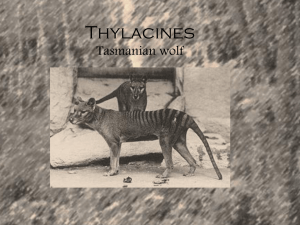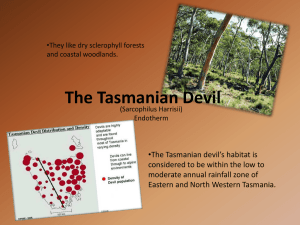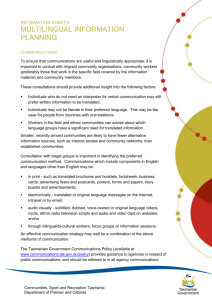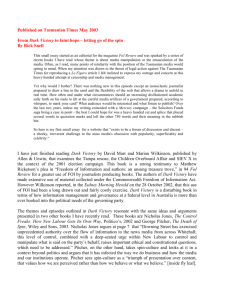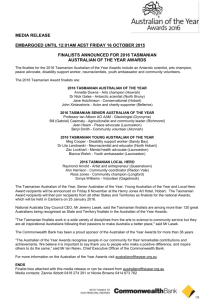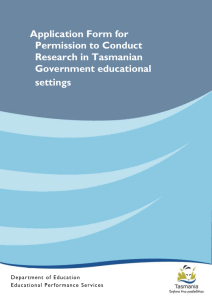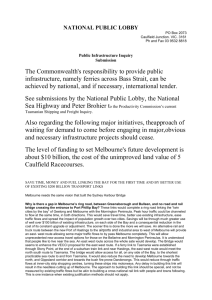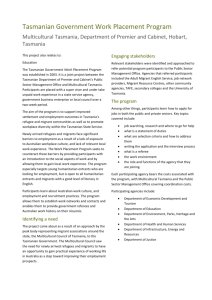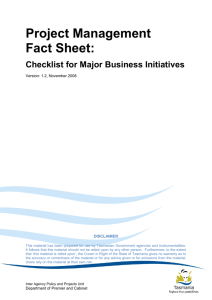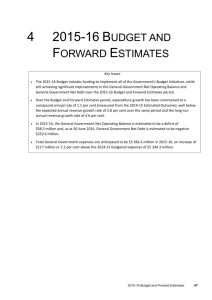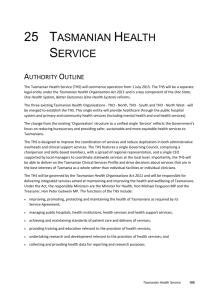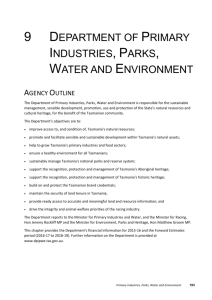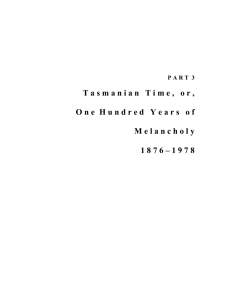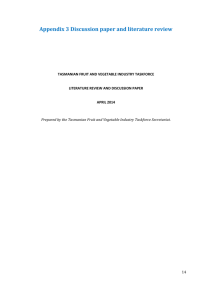Appendix 4 - Budget Presentation and Accounting Issues
advertisement
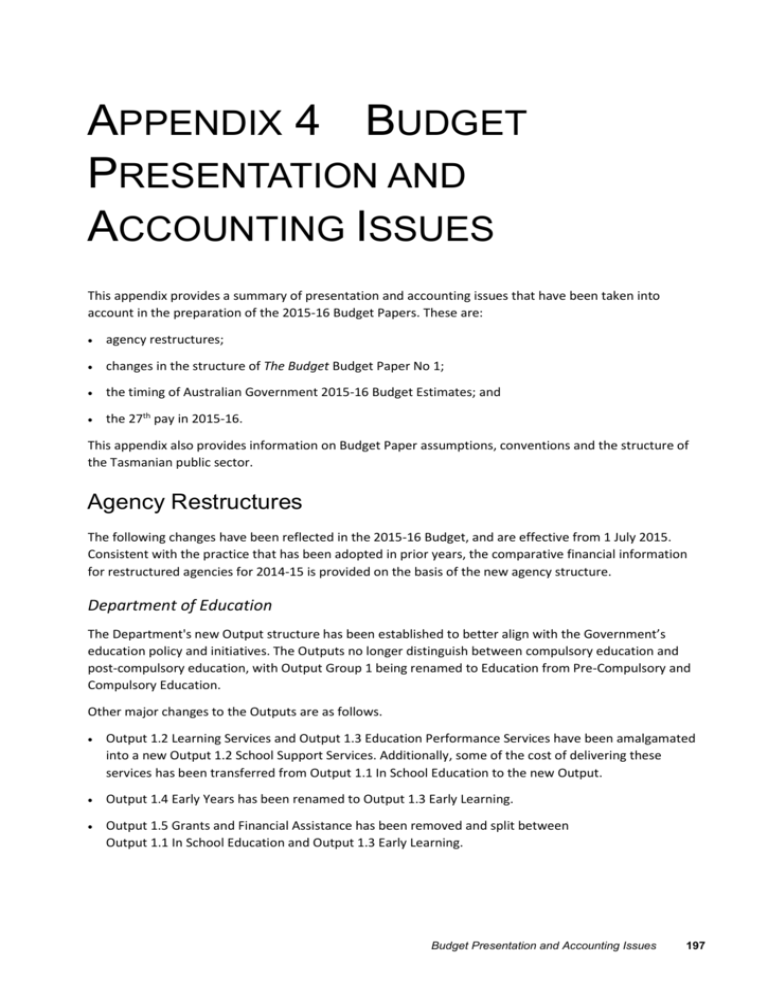
APPENDIX 4 BUDGET PRESENTATION AND ACCOUNTING ISSUES This appendix provides a summary of presentation and accounting issues that have been taken into account in the preparation of the 2015-16 Budget Papers. These are: agency restructures; changes in the structure of The Budget Budget Paper No 1; the timing of Australian Government 2015-16 Budget Estimates; and the 27th pay in 2015-16. This appendix also provides information on Budget Paper assumptions, conventions and the structure of the Tasmanian public sector. Agency Restructures The following changes have been reflected in the 2015-16 Budget, and are effective from 1 July 2015. Consistent with the practice that has been adopted in prior years, the comparative financial information for restructured agencies for 2014-15 is provided on the basis of the new agency structure. Department of Education The Department's new Output structure has been established to better align with the Government’s education policy and initiatives. The Outputs no longer distinguish between compulsory education and post-compulsory education, with Output Group 1 being renamed to Education from Pre-Compulsory and Compulsory Education. Other major changes to the Outputs are as follows. Output 1.2 Learning Services and Output 1.3 Education Performance Services have been amalgamated into a new Output 1.2 School Support Services. Additionally, some of the cost of delivering these services has been transferred from Output 1.1 In School Education to the new Output. Output 1.4 Early Years has been renamed to Output 1.3 Early Learning. Output 1.5 Grants and Financial Assistance has been removed and split between Output 1.1 In School Education and Output 1.3 Early Learning. Budget Presentation and Accounting Issues 197 Output Group 2 Post-Compulsory Education has been removed with the former Output 2.1 Tasmanian Academy and Output 2.2 Post-Compulsory Education now amalgamated into Output 1.1 In School Education. A new Output 1.4 Statutory Offices has been created and incorporates the former Output 2.3 Tasmanian Qualifications Authority. The LINC Tasmania Output has changed from Output Group 3 to Output Group 2. Department of Primary Industries, Parks, Water and Environment Output 1.3 Service Tasmania within the Department of Primary Industries, Parks, Water and Environment has been transferred to Output 3.2 Management and Ongoing Development of Service Tasmania within the Department of Premier and Cabinet to reflect the consolidation of Service Tasmania's operations under a single agency. The former Output Group 3 Resource Management and Conservation has been renamed Natural and Cultural Heritage. The former Output 3.2 Conservation of Tasmania's Flora and Fauna has been consolidated into Output 3.1 which has been renamed Resource Management and Conservation. The former Output 4.2 Water Resource Assessment has been consolidated into Output 4.1 Water Resource Management. The former Output 9.1 Historic Heritage Services has been transferred to Output Group 3 and becomes Output 3.2 Historic Heritage Services. The former Output 9.2 Aboriginal Heritage has been transferred to Output Group 3 and becomes Output 3.3 Aboriginal Heritage. The former Output 9.3 Royal Tasmanian Botanical Gardens has been transferred to Output Group 3 and becomes Output 3.4 Royal Tasmanian Botanical Gardens. As at 1 July 2015, the Minister for Racing Portfolio will be transferred from the Department of State Growth to the Department of Primary Industries, Parks, Water and Environment. The Racing Portfolio includes the former Department of State Growth Output 5.1 Racing Regulation and Policy, and the Tasmanian Racing Assistance Administered payment. The 2015-16 Budget reflects these Outputs within the Department of Primary Industries, Parks, Water and Environment as Output 9.1 Racing Regulation and Policy, and the Tasmanian Racing Assistance payment as an Administered expense. The Minister for Racing remains the Deputy Premier, Hon Jeremy Rockliff, MP. Department of Premier and Cabinet Output 1.3 Service Tasmania within the Department of Primary Industries, Parks, Water and Environment has been transferred to Output 3.2 Management and Ongoing Development of Service Tasmania within the Department of Premier and Cabinet to reflect the consolidation of Service Tasmania's operations under a single agency. 198 Budget Presentation and Accounting Issues Department of State Growth As a result of the transfer of the Racing Portfolio from State Growth to the Department of Primary Industries, Parks, Water and Environment, the former Output Group 7 Subsidies and Concessions has become Output Group 6 Subsidies and Concessions, and the former Output Group 6 Cultural and Creative Industry Development has become Output Group 5 Culture and Creative Industries. The former Output 7.2 Metropolitan General Access Regular Passenger Transport Services has been renamed Output 6.2 Metropolitan General Access Services, and the former Output 7.4 Non-Metropolitan General Access Regular Passenger Transport Services has been renamed Output 6.4 Non-Metropolitan General Access Services. Tasmanian Health Service As part of the Government's 'One State, One Health System, Better Outcomes' initiative, the existing three Tasmanian Health Organisations (THOs) will be replaced by a single Tasmanian Health Service (THS). The restructure results in the amalgamation of the previous three THO Outputs in the Department of Health and Human Services into a single Tasmanian Health Service Output. The restructure also results in the removal of the three separate THO chapters in Government Services Budget Paper No 2 and the presentation of a single THS chapter. Cancer Screening Services has been transferred from the Department of Health and Human Services to the new THS Agency to reflect new service delivery arrangements. Changes in the Structure of The Budget Budget Paper No 1 A review of the information provided in The Budget Budget Paper No 1 is undertaken each year to ensure it reflects the current Budget environment. Changes implemented in 2015-16 are: the removal of the Budget Savings and Revenue Strategies chapter from The Budget Budget Paper No 1. This change reflects the fact that no new additional structural savings measures are required to be implemented by agencies as a result of the 2015-16 Budget; and the addition of the 2014-15 Estimated Outcome as an appendix to The Budget Budget Paper No 1. No Estimated Outcome information was presented in the 2014-15 Budget due to the timing of the presentation of the Budget in August 2014. Australian Government 2015-16 Budget Estimates Estimates presented in this Budget Paper were required to be finalised prior to the release of the Australian Government's 2015-16 Budget. As a result, estimates of Specific Purpose Payments and some National Partnership Payments (or data based on these estimates) may differ from those published in the Australian Government's 2015-16 Budget. Any changes will be reflected in the 2015-16 Revised Estimates Report. Budget Presentation and Accounting Issues 199 27th Pay in 2015-16 Salary payments to employees in the General Government Sector are made fortnightly. This usually means that there are 26 pay days in each year. However, approximately once every 11 years, there are 27 fortnightly pay days in a financial year. The next year with 27 pay days for agencies (other than the Department of Health and Human Services) will be 2015-16. The Department of Health and Human Services makes its salary payments on a different day each fortnight to the rest of the General Government Sector and will make a 27th pay in a different year. Additional funding is provided to agencies for this additional cost from the Consolidated Fund. On a cash basis, this is included in the Appropriation to agencies and in Employee benefits on the agency Statement of Cash Flows. However, on an accrual basis, there is no impact on the agency Statement of Comprehensive Income as the additional cash payment is offset by an adjustment to accrued Employee benefits expense. This adjustment to accrued Employee benefits expense is also reflected in a reduction in the liability for Employee benefits in the agency Statement of Financial Position. ASSUMPTIONS UNDERLYING THE 2015-16 BUDGET AND FORWARD ESTIMATES Revenue Revenue estimates are prepared on the basis of a number of assumptions and use information provided to the Department of Treasury and Finance (Treasury) by various entities, including the Australian Government, government agencies, Government Business Enterprises (GBEs) and State-owned Companies (SOCs). The 2015-16 Budget and Forward Estimates for revenue are prepared on the following basis: Grants are based on agreements with the Australian Government. It is assumed that, unless otherwise stated, Specific Purpose Payments will be indexed as advised by the Australian Government; all General Purpose Payments, including GST revenue, received from the Australian Government can be used at the State's discretion; Taxation revenue for the Forward Estimates utilises economic forecasts prepared by Treasury. Taxation estimates reflect changes in tax policy up to and including any changes announced in the Budget; Interest income is estimated by Treasury and reflects anticipated cash holdings within the Public Account and forecast interest rates; and Sales of goods and services; Fines, Fees and charges; and Other revenue are based on the best estimates of those agencies which provide the goods or services, or which actively manage the particular revenue item. 200 Budget Presentation and Accounting Issues Expenses The 2015-16 Budget and Forward Estimates for expenses are prepared on the following basis: projections over the Forward Estimates reflect the level and timing of expenditure anticipated by agencies; borrowing costs are estimated by Treasury and reflect anticipated borrowings within the Public Account and forecast interest rates; the Forward Estimates are premised on the provision of future public sector wage outcomes of a maximum of two per cent per annum including identified productivity offsets; indexation of general operating expenses is provided at 2.5 per cent over the Forward Estimates period; funding provided to the Department of Health and Human Services for medical and pharmaceutical supplies is indexed at a rate of 4.0 per cent per annum; and agencies are fully funded for expected changes in Administered Items. BUDGET PAPER CONVENTIONS The information provided in the Budget Papers has been prepared taking into account the following conventions. Figures in tables and in the text have been rounded. Discrepancies in tables between totals and sums of component items reflect rounding. Percentage changes in all tables are based on the underlying unrounded amounts. The notation used in the Budget Papers is as follows: na not available, or not applicable …. zero, or rounded to zero $'000 $ thousand $m $ million CLASSIFICATION OF THE TASMANIAN PUBLIC SECTOR The Tasmanian Public Sector comprises several different types of entities. These are classified according to the sectors comprising the Uniform Presentation Framework, namely General Government, Public Non-Financial Corporations (PNFC) or Public Financial Corporations (PFC) Sectors. Budget Presentation and Accounting Issues 201 The General Government Sector (GGS) comprises those agencies of government, where the primary function is to provide public services. These services are mainly non-market in nature, for the collective consumption of the community, or involve the transfer or redistribution of income. GGS services are financed mainly through taxes and other compulsory levies. This Sector includes government departments and a number of entities that operate outside the Public Account including the Inland Fisheries Service, Marine and Safety Tasmania, the Royal Tasmanian Botanical Gardens and the State Fire Commission. The PNFC Sector comprises entities that cover the majority of their expenses from revenue by the sales of goods and services and which are mainly market, non-regulatory and non-financial in nature. This Sector includes the State-owned Companies and Government Business Enterprises. These entities have a variety of functions and responsibilities, are established in varying ways and also have different relationships with the Budget. The PFC Sector comprises two organisations in Tasmania, the Tasmanian Public Finance Corporation and the Motor Accidents Insurance Board. These entities perform central bank functions or have the authority to incur financial liabilities and acquire financial assets in the market on their own account. The following provides a breakdown of the Tasmanian Public Sector entities by sector. General Government Sector Department of Education Department of Health and Human Services Department of Justice Department of Police and Emergency Management Department of Premier and Cabinet Department of Primary Industries, Parks, Water and Environment Department of State Growth Department of Treasury and Finance (including Finance-General) House of Assembly Inland Fisheries Service Integrity Commission Legislative Council Legislature-General Marine and Safety Tasmania Office of the Director of Public Prosecutions Office of the Governor Office of the Ombudsman Royal Tasmanian Botanical Gardens 202 Budget Presentation and Accounting Issues State Fire Commission Tasmanian Audit Office Tasmanian Health Service TasTAFE Tourism Tasmania Public Non-Financial Corporations Sector Aurora Energy Pty Ltd Forestry Tasmania Hydro Tasmania Macquarie Point Development Corporation Metro Tasmania Pty Ltd Port Arthur Historic Site Management Authority Private Forests Tasmania Public Trustee Tasmanian Irrigation Pty Ltd Tasmanian Ports Corporation Pty Ltd Tasmanian Railway Pty Ltd Tasmanian Networks Pty Ltd Tasracing Pty Ltd TT-Line Company Pty Ltd Public Financial Corporations Sector Motor Accidents Insurance Board Tasmanian Public Finance Corporation Budget Presentation and Accounting Issues 203
